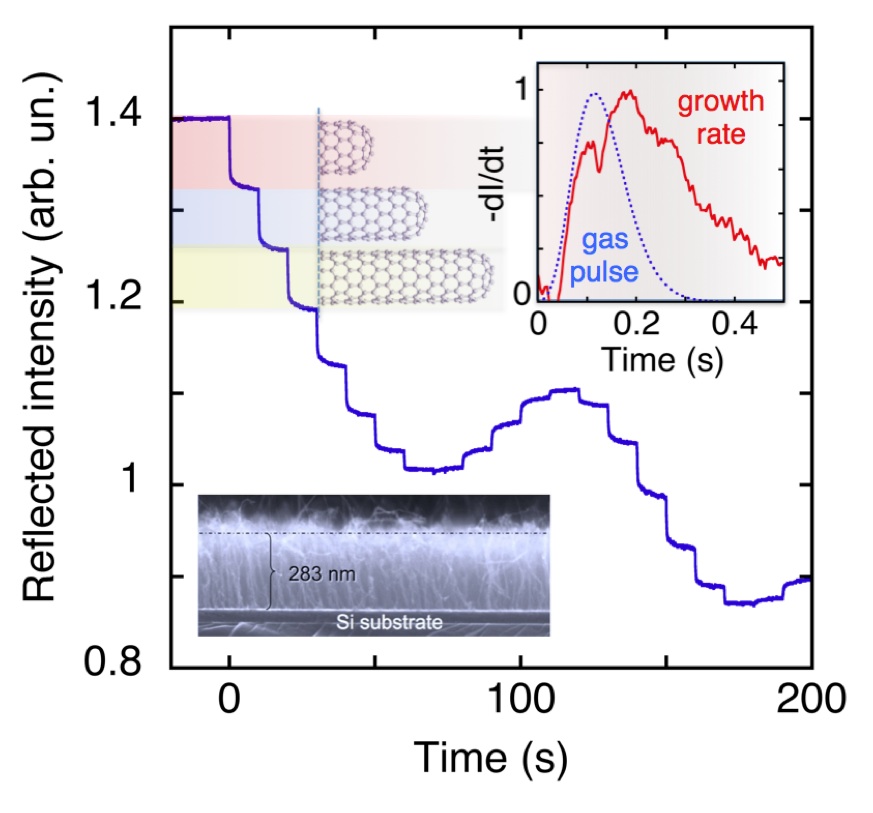Fast nucleation kinetics and incremental growth of short single-wall carbon nanotube arrays
Alexander A. Puretzky†, David B. Geohegan†, Jeremy J. Jackson‡, Sreekanth Pannala, Gyula Eres‡, Christopher M. Rouleau†, Karren L. More*, Norbert Thonnard**, and Jason D. Readle‡
†Center for Nanophase Materials Sciences and
‡Materials Science and Technology Division and
*Shared Research Equipment Facility, ** Univ. of Tennessee,
Oak Ridge National Laboratory, Oak Ridge, Tennessee 37831-6488, United States
PDF of article "Incremental Growth of Short SWNT Arrays by Pulsed Chemical Vapor Deposition" published online in Small (2012).
Supplemental Information
Figure 1. Time-resolved laser reflectivity (TRR) of SWNT nucleation and aligned array growth is measured in response to fast acetylene gas pulses used for chemical vapor deposition (CVD), revealing kinetics with the fastest time resolution to date. Each small step in the TRR curve corresponds to an increment of ~ 25 nm in array height, and the derivative of each transient TRR response reveals the growth kinetics on each pulse. For example, on the first gas pulse (top inset) two peaks corresponding to nucleation and growth (within and beyond the gas pulse temporal profile) are revealed. Using pulsed-CVD and in situ reflectivity, continuous SWNTs without kinks or sidewall defects were grown to precise heights in aligned arrays (bottom inset).
The kinetics of nanotube nucleation and growth were measured on the fastest time scale to date, and were used to incrementally grow ultrashort single-wall carbon nanotube (SWNT) arrays. Using time-resolved laser reflectivity and short (0.2 s) acetylene gas pulses, the kinetics of nanotube cap formation was resolved within ~ 50 ms after arrival of the feedstock gas and a time-delayed growth phase was observed to continue after the gas was gone (Figure 1). These kinetics indicate the formation of intermediate species by autocatalytic reactions. This understanding permitted the incremental growth of ultrashort (> 60 nm) arrays of continuous and smooth SWNTs within a special processing window wherein gas fluxes are sufficiently high to drive rapid nucleation and growth, but low enough to avoid growth termination. Using well-defined pulses of acetylene and real-time height measurement, ultrashort SWNT arrays were grown incrementally by stopping and restarting their growth with ~ 25 nm precision. Predictive incremental growth using pulsed CVD controlled by in situ TRR opens new possibilities for the precise synthesis of short SWNT arrays for a variety of biological, thermal, optoelectronic, and sensing applicationsCredit - Note: Synthesis science sponsored by the Materials Sciences and Engineering Division, Office of Basic Energy Sciences, U.S. Department of Energy. Sample characterization by Raman spectroscopy at the Center for Nanophase Materials Sciences (CNMS) and electron microscopy at the Shared Research Equipment (SHaRE) User Facility sponsored at Oak Ridge National Laboratory by the Scientific User Facilities Division, Office of Basic Energy Sciences, U.S. Department of Energy.

